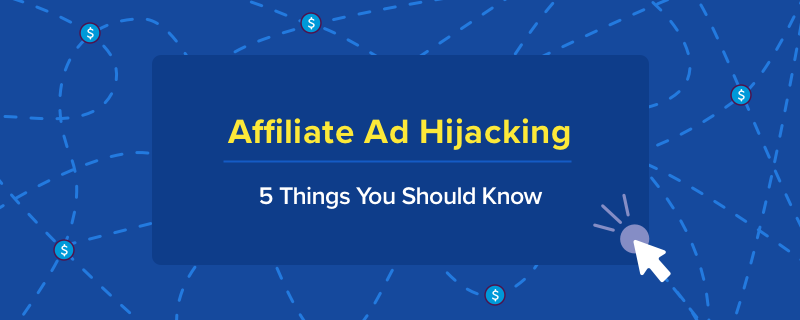Notice anything fishy in your PPC metrics lately? Is your impression share on branded terms lower than normal? Are the conversion rates for one of your affiliates almost identical to your branded paid search campaigns? You may be the target of an affiliate ad hijacker.
While most affiliates don’t engage in ad hijacking, when someone does, the impact can be very damaging to a brand’s ppc programs. Affiliates are supposed to be driving incremental revenue and helping you reach your goals, not stealing clicks and making your paid search programs more expensive!
In this blog, we’ll answer the five most common questions about affiliate ad hijacking and give you the information you need to identify and stop ad hijacking.
#1 What is ad hijacking?
Ad hijacking (also known as brand poaching, direct linking, URL jacking) is when an affiliate tries to impersonate the brand by running ads that look identical to the brand’s ads. By using similar headlines, descriptions, and the same display URL, these affiliate hijackers increase the odds that unsuspecting users will click on their ads instead of the brand’s ads. These clicks convert to purchases, which means the affiliate earns 5-10% commission on these purchases. In short, these types of affiliates are stealing money in the form of unearned commissions from brands.
#2 What does ad hijacking look like?
To someone surfing the internet and looking at a Search Engine Results Page, ad hijacking doesn’t look any different from regular advertising. It happens when a rogue affiliate creates a paid search ad that is an exact copy of the ad created by the brand. Customers typically have no idea they have clicked on an affiliate ad, and the affiliate is paid commission for conversions that the brand would have captured directly.
What’s happening behind the ad:

The example above shows how ads are supposed to work. The brand’s ad leads directly to their own site via their own tracking link. The brand pays a few cents per click.

This next example shows ad hijacking. The affiliate places an ad that goes immediately through their tracking link to the brand’s site. They therefore are stealing the commission on any subsequent purchase and are increasing the cost-per-click on branded search terms.

In this final and most egregious example of ad hijacking, the affiliate places an ad and masks its referral through a series of redirect urls. The affiliate hijacker not only receives an unearned commission but it is also using evasive techniques to avoid detection. This scenario is particularly damaging to a brand’s affiliate marketing program because it is virtually impossible to find without help of a paid search monitoring tool.
#3 Why is ad hijacking harmful?
Ad Hijacking has several negative impacts including:
Reduction in brand revenue: Ad hijackers steal clicks, eat into profit margins and gain unearned commissions. Brands lose money when they have to compete with their affiliates for conversions or sales from paid search keywords. Metrics such as impression share and ROI are also affected – the brand’s metrics become skewed and accurate revenue attribution becomes impossible.
Channel conflict: When the affiliate and the brand are advertising on the same keywords, channel conflict ensues. The search engines will only show one advertisement at a time with the same display URL. As a result the affiliate and brand are competing against one another to be on the SERP and increasing the brand’s CPCs. The affiliate is supposed to be bringing new business to the brand, not diverting existing business.
Messaging conflict: The affiliate’s ad, which visitors think is the brand’s ad, may not match the brand’s messaging. Outdated offers and off-brand messaging are common. Since the search engines only allow an advertiser’s domain to appear once on a given SERP, affiliate hijackers often replace brands’ ads with their own— taking away the brand’s control of their own message.
#4 How does a brand know if its ads are being hijacked?
Ad hijackers use techniques like geo-targeting and dayparting that make it virtually impossible to find them without the help of an automated paid search monitoring tool. However, three indicators of ad hijacking include:
- Spikes in referral traffic and conversions from affiliates that are not well known to the brand.
- Nearly identical conversion rates for an affiliate and branded paid search.
- A reduction in impressions and clicks. Since the search engines don’t allow multiple ads with the same display URL to serve at the same time, the affiliate hijacks ads replace the brand’s ads, which lead to a reduction in impression share of the brand’s ads. A good rule of thumb is that if the affiliate is not a well known site, or the brand doesn’t have a strong working relationship with them, it’s worth taking a closer look at how the affiliate is driving their traffic.
#5 How can you stop affiliate ad hijacking?
The first line of defense against ad hijackers is airtight affiliate agreements. Be sure your agreements clearly state what your brand-bidding policies are and what the consequences are for violating the agreements.
Affiliates who engage in this type of nefarious behavior don’t want to be discovered by the brand. They use tactics like geotargeting and dayparting to avoid detection, making it almost impossible to uncover and stop them. While some of the red flags mentioned above are indicators of ad hijacking, manual investigative methods are time consuming and error-prone. Automated solutions, like BrandVerity’s paid search monitoring tool, make identifying ad hijacking easy.
The BrandVerity tool automatically crawls the web, finding infringements that even the most experienced PPC manager wouldn’t be able to find. You can set your policies up so that they will flag violations of your affiliate agreements, making enforcement of these agreements much easier. Once BrandVerity flags an issue, the affiliate manager can quickly notify the affiliate, partner or search engine about the violation using an email template from within the tool.
Want to see if your branded keywords are being hijacked by your affiliates?

